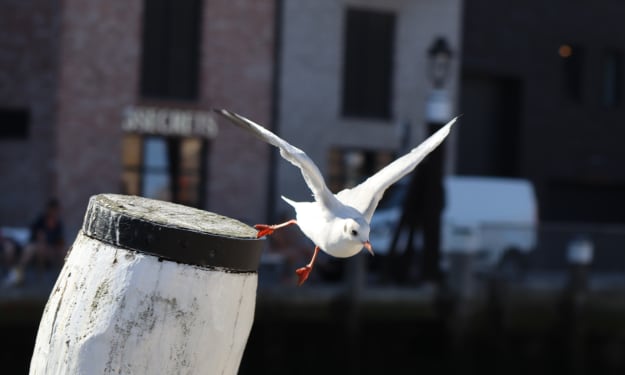Iron Butterfly
I was struck by the texture, the way the curves of the twisted metal complimented the sweeping shape of the chrysalis, and how the bright green pod stood out against the dark and dimensional black cage. To my eye, the chrysalis almost glows. It reminds me of an emerald suspended from the most delicate chain, hanging within in an elaborate pendant or earring. A crown jewel, indeed, befitting a monarch.

The monarch butterfly is in trouble. Their numbers have declined 90% over the past 20 years due to a combination of land development and the widespread use of pesticides and weedkillers, which has decimated the population of milkweed – the monarch’s only food source.
I live in North Florida, near the St. Marks National Wildlife Refuge, where monarch butterflies from all over the eastern United States gather every October to prepare for their annual mass migration to Mexico. St. Marks is one of the top five migration viewing sites in the United States.
Monarchs, like bees, are pollinators. They play an important role in maintaining biological diversity. Monarch caterpillars feed almost exclusively on milkweed plants – so they won’t hurt your fruits or vegetables! There are approximately 20 milkweed species that are native to Florida.
Unfortunately, most of the native milkweed species are not commercially available. The tropical variety found in most retail nurseries and big box stores (Asclepias curassavica) is not the best food plant for monarch larvae, is somewhat invasive and should not be planted.
Having witnessed the incredible beauty of a monarch migration and wanting to do our part to preserve this natural wonder for future generations, my wife and I, along with several friends have recently begun planting milkweed and protecting caterpillars in our yards and gardens. Our hope is that by consciously “choosing” to protect and preserve the monarch population we will be able pass this joy along to our children. (We also raise bees and harvest honey.)
The consequences of indifference are clear. When I moved to Florida in 1985, it was still fairly common to see fireflies at night. This timeless pleasure, sadly, has faded in most urban areas, where light pollution outshines their dim lights and prevents them from making a love connection, and as an unintended consequence of mosquito abatement.
About the photo
This year, my wife and I witnessed ten monarch caterpillars happily devouring our small, but growing patch of milkweed. I charged up my GoPro, hoping to capture the transformation of a chrysalis and the emergence of a butterfly.
We watched, with pleasure, as the tiny larvae grew big and fat, thinking about how we were going to document the miracle of transformation.
And then, one by one, they disappeared, eaten by birds, wasps, lizards, and any manner of unknown predators. Some of our friends tent their milkweed at the first sign of caterpillars. Others “wrangle” the larvae into little screened cubes, protective bunkers, stocked with pots of milkweed. So far, we’ve opted to let nature take its course.
This picture, which I call “Iron Butterfly,” represents the lone survivor of this year’s caterpillar crop, a world-wise pupa who built its sleeping chamber within the protective, decorative armature of a tiki torch pole.
I was struck by the texture, the way the curves of the twisted metal complimented the sweeping shape of the chrysalis, and how the bright green pod stands out against the dark and dimensional black cage. To my eye, the chrysalis almost glows. It reminds me of an emerald suspended from the most delicate chain, hanging within in an elaborate pendant or earring.
I captured this image on my iPhone 8, in natural evening light, narrowing the focus to just the chrysalis to create a pleasing blur for dimension and depth of field. I was very happy with the result – including the unintentional warmth and separation created by the amber glow of the pine deck rails in the background.
This wasn’t intended as anything other than a snapshot to document and celebrate the beauty of the small and often overlooked miracles that are ours to behold, if only we’d take the time to slow down and look for them. I submit it for your consideration.
A crown jewel, indeed, befitting a monarch.
About the Creator
Brad Kuhn
Multi-media producer in Jacksonville, Fla. He has co-written three books and ghostwritten several more. His most recent offering is Dirty Work: The Untold Story of My Secret Mission to Steal Back TWA Flight 847 From Hezbollah.






Comments
There are no comments for this story
Be the first to respond and start the conversation.